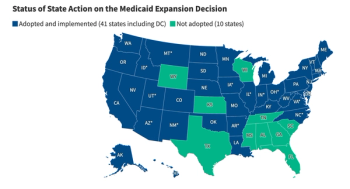
Advanced Analytics Triple Win for Payers
The use of advanced analytics by payers can improve administrative and medicalcosts, provider satisfaction and member health.
Virtually every organization working in healthcare - payers, hospitals, physicians, and employer group health plans - must do more with fewer resources. That's especially true for payers.
CaronThe Affordable Care Act may have created what Gartner Research estimates to be a $33 billion opportunity for payers in the form of new individual customers, but it also generated new demands. For starters, payers are now held to a higher standard for administrative spend.
The ACA's Medical Loss Ratio (MLR) provisions require payers to spend at least 80 percent and 85 percent of premium dollars, for individuals/small groups and large employer group health plans respectively, on medical care and quality activities or issue a rebate to customers. As intended, this limits profits, salaries and administrative spend on activities such as customer service, network and product development, and information technology.
At the same time, payers' information technology demands have increased. For some, initial ACA enrollments provided the impetus to invest in more robust systems for benefit configuration, enrollment and eligibility management. For others, ICD-10 conversion necessitated new systems.
Concurrently, ACA provisions encouraged payers to create accountable care organizations and value-based contracts with hospitals and physicians. In contrast to typical fee-for-service contracts, these arrangements are administered differently and require sophisticated solutions to accurately measure network quality performance and outcomes and achieve the desired effect of meaningful personalized and population health.
The growth of risk-sharing contracts also creates the opportunity to consolidate and sunset legacy software and support contracts as a Geneia client recently did.
Like many payers, Geneia's payer clients have cobbled together existing systems to try to manage network performance and member health within the scope of value-based contracts. These systems were previously licensed for another use and now - sometimes successfully and sometimes not - are being repurposed for use in risk-bearing arrangements and population health.
For example, some payers are using a tool that was originally licensed to measure actuarial risk to understand and manage individual and population risk. In our experience, payers try to integrate as many as a dozen tools to achieve population health, often from different vendors and almost always lacking the scalability and flexibility of one advanced analytics solution.
Let's look more closely at one representative client. This payer responded to ACA incentives and initiated the first of many accountable care arrangements in 2011.
Rather than license a new platform, the plan initially repurposed eight existing software products from seven different vendors. Each of these tools had a different function, including:
- Provider profiling
- Predictive modeling for underwriting
- Member disease and case identification and stratification
- Healthcare Effectiveness Data and Information Set (HEDIS) measurement to close gaps in care
- Physician portal for patient management
- Employer group reporting from two different companies, and
- Member outreach and analytics.
Together, the annual licensing fees exceeded $2.85 million, and most were expected to increase in the coming years. The annual fee for the physician portal, for example, was projected to nearly double by 2017.
Equally importantly, there were seven vendor relationships to manage along with periodic upgrades for eight products, all of which required independent testing efforts. The staffing demands to manage these relationships and upgrades were extensive. Some estimates suggested that the required staffing added an additional 50 percent to the annual licensing costs of $2.85 million.
Two years ago, the payer decided to find one solution that could not only replace these eight retrofitted tools, but also was created expressly to measure, manage and improve population health within the context of value-based contracts. That's what the most innovative advanced analytics platforms readily do.
The payer sunsetted the eight tools and licensed one advanced analytics and insights platform to support all of its accountable care arrangements and population health initiatives. The plan reaped many benefits from this integrated approach, including:
- A savings of $2.85+ million in annual licensing fees to the seven vendors with a net savings of approximately $1.7 million after its investment in the analytics platform;
- An expense reduction of nearly $1.4 million in staffing no longer needed to support seven vendors;
- Medical savings due to a lower rate of growth for overall medical and pharmacy costs and fewer emergency department visits, hospitalizations and readmissions;
- A streamlined approach to managing population health and risk-based contracts that increased physician satisfaction as well as provider's ability to meet contracted quality and cost goals; and
- Improved member health as the result of better performance on HEDIS measures and more effective chronic disease management.
A triple win in healthcare is a rarity. Yet that is what this payer achieved as the result of licensing an advanced analytics and insights platform: improved administrative and medical costs, provider satisfaction and member health.
Newsletter
Get the latest industry news, event updates, and more from Managed healthcare Executive.





















































